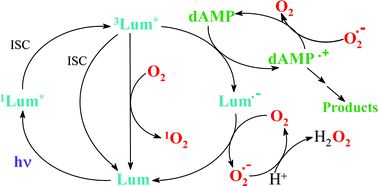Mechanism of electron transfer processes photoinduced by lumazine
Abstract

* Corresponding authors
a
Instituto de Investigaciones Fisicoquímicas Teóricas y Aplicadas (INIFTA), Departamento de Química, Facultad de Ciencias Exactas, Universidad Nacional de La Plata, CCT La Plata-CONICET. Casilla de Correo 16, Sucursal 4, La Plata, Argentina
E-mail:
clorente@inifta.unlp.edu.ar
Fax: +54 221 4254642
Tel: +54 221 4257430 int.153
b Laboratoire des Interactions Moléculaires Réactivité Chimique et Photochimique (IMRCP), UMR 5623-CNRS/UPS, Université Paul Sabatier (Toulouse III), 118, route de Narbonne, Toulouse cédex 9, France

 Please wait while we load your content...
Something went wrong. Try again?
Please wait while we load your content...
Something went wrong. Try again?
M. P. Denofrio, M. L. Dántola, P. Vicendo, E. Oliveros, A. H. Thomas and C. Lorente, Photochem. Photobiol. Sci., 2012, 11, 409 DOI: 10.1039/C1PP05315A
To request permission to reproduce material from this article, please go to the Copyright Clearance Center request page.
If you are an author contributing to an RSC publication, you do not need to request permission provided correct acknowledgement is given.
If you are the author of this article, you do not need to request permission to reproduce figures and diagrams provided correct acknowledgement is given. If you want to reproduce the whole article in a third-party publication (excluding your thesis/dissertation for which permission is not required) please go to the Copyright Clearance Center request page.
Read more about how to correctly acknowledge RSC content.
 Fetching data from CrossRef.
Fetching data from CrossRef.
This may take some time to load.
Loading related content
